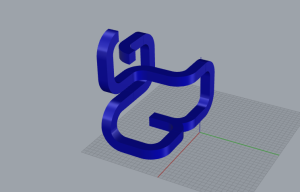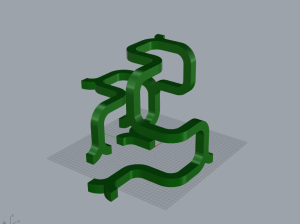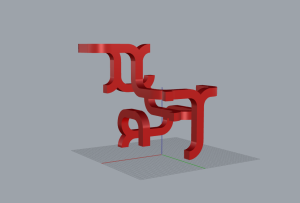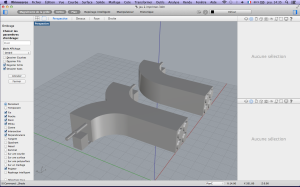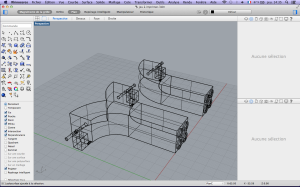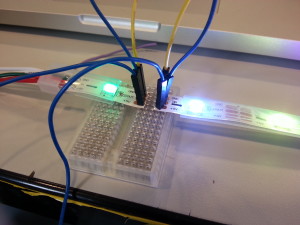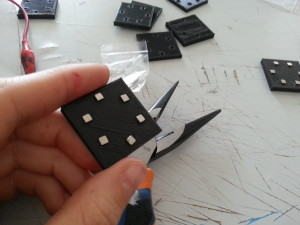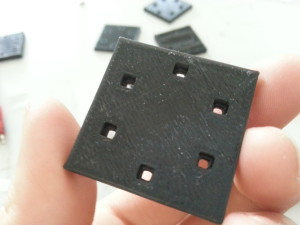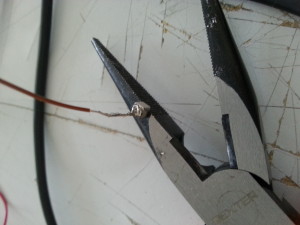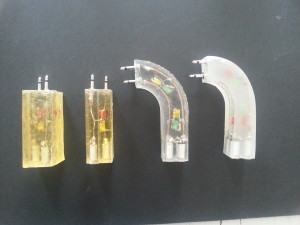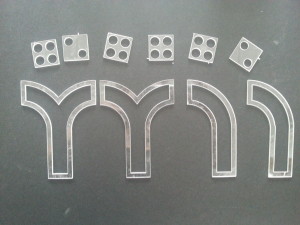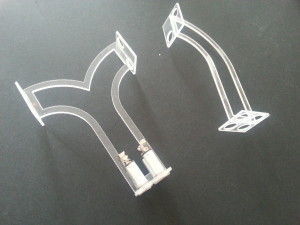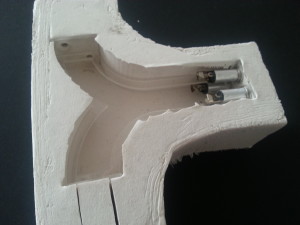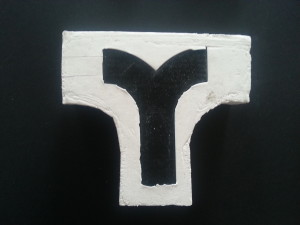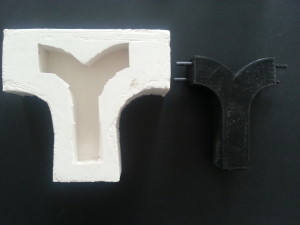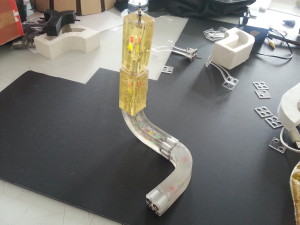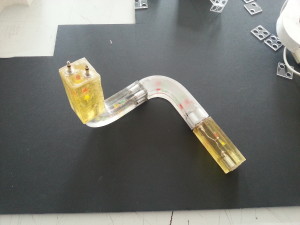Jeu de construction lumineux (et qui change de couleur!)
Auteur(s)
Clara Kernreuter
Intentions / Contexte
Ce travail est une recherche continuelle autour d’un jeu de construction lumineux. La recherche débute par la définition d’une forme qui puisse se développer ludiquement et intuitivement dans l’espace afin de construire des structures. Ensuite vient s’ajouter l’élément lumineux, donc l’intégration d’un circuit électronique dans les pièces de la structure. Le système d’accroche entre les pièces est donc contraint par le circuit, le sens de courant, la conductivité…Enfin, la lumière des pièces doit être changeante et évoluer en fonction du type de branchement entre les pièces , du nombre de pièces.
en résumé ce produit doit être:
-un jeu
-ludique et intuitif
-se développer dans l’espace
-lumineux
-évoluer soit par la couleur soit par l’intensité lumineuse en fonction des pièces branchées les unes aux autres.
Principe de Fonctionnement
A : La version sans code: les pièces sont en résine transparente, elles s’éclairent dès qu’elles se branchent les unes les autres et changent de couleur en fonction du sens de branchement. Il y a deux couleurs possibles par pièces.
-4 LED par module/pièce. e(x: 2 rouges/2vertes ou 2 vertes/2 jaunes…) avec des résistances.
-une pile 9 volt pour alimenter.
-des jacks 3.5 mm mono mâles et femelles pour les branchements. (http://www.selectronic.fr/connecteur-jack-3-5mm-mono-male-argente.html) (http://www.selectronic.fr/connecteur-jack-3-5mm-stereo-femelle-argente.html)
B : La version codée: les pièces changent de couleur ou d’intensité en fonction du nombre de branchement, il est possible de faire changer toutes les couleurs de toutes les pièces d’un seul coup.
-une strip de led programmable. (https://hackspark.fr/fr/1m-30leds-ws2812-led-strip-neopixel-compatible.html)
-des petits aimants cubiques.
-une alimentation secteur.
-arduino
Besoins / Compétences
La deuxième version nécessite d’utiliser le logiciel Arduino.
1 / Recherche d’une forme:
premières recherches en dessin d’une évolution dans l’espace.
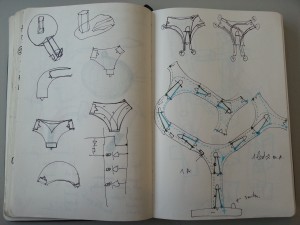
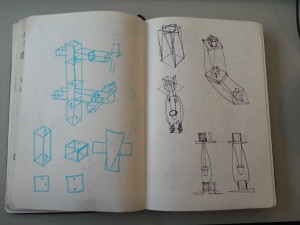
Recherches en 3 dimensions après maquettes pour visualiser le développement.
Forme finale choisie, préparation 3D dans le but de les imprimer avec une Maker Box et mouler les impressions.
Une des deux formes imprimées:
création de son moule.
/* SparkFun WS2812 Breakout Board Example
SparkFun Electronics
date: July 25, 2013
license: GNU GENERAL PUBLIC LICENSE
Requires the Adafruit NeoPixel library. It’s awesome, go get it.
https://github.com/adafruit/Adafruit_NeoPixel
This simple example code runs three sets of animations on a group of WS2812
breakout boards. The more boards you link up, the better these animations
will look.
For help linking WS2812 breakouts, checkout our hookup guide:
https://learn.sparkfun.com/tutorials/ws2812-breakout-hookup-guide
Before uploading the code, make sure you adjust the two defines at the
top of this sketch: PIN and LED_COUNT. Pin should be the Arduino pin
you’ve got connected to the first pixel’s DIN pin. By default it’s
set to Arduino pin 4. LED_COUNT should be the number of breakout boards
you have linked up.
*/
#include <Adafruit_NeoPixel.h>
#include « WS2812_Definitions.h »
#define PIN 4
#define LED_COUNT 11
// Create an instance of the Adafruit_NeoPixel class called « leds ».
// That’ll be what we refer to from here on…
Adafruit_NeoPixel leds = Adafruit_NeoPixel(LED_COUNT, PIN, NEO_GRB + NEO_KHZ800);
void setup()
{
leds.begin(); // Call this to start up the LED strip.
clearLEDs(); // This function, defined below, turns all LEDs off…
leds.show(); // …but the LEDs don’t actually update until you call this.
}
void loop()
{
// Ride the Rainbow Road
for (int i=0; i<LED_COUNT*10; i++)
{
rainbow(i);
delay(100); // Delay between rainbow slides
}
// Indigo cylon
// Do a cylon (larson scanner) cycle 10 times
for (int i=0; i<10; i++)
{
// cylon function: first param is color, second is time (in ms) between cycles
cylon(INDIGO, 500); // Indigo cylon eye!
}
// A light shower of spring green rain
// This will run the cascade from top->bottom 20 times
for (int i=0; i<20; i++)
{
// First parameter is the color, second is direction, third is ms between falls
cascade(MEDIUMSPRINGGREEN, TOP_DOWN, 100);
}
}
// Implements a little larson « cylon » sanner.
// This’ll run one full cycle, down one way and back the other
void cylon(unsigned long color, byte wait)
{
// weight determines how much lighter the outer « eye » colors are
const byte weight = 4;
// It’ll be easier to decrement each of these colors individually
// so we’ll split them out of the 24-bit color value
byte red = (color & 0xFF0000) >> 16;
byte green = (color & 0x00FF00) >> 8;
byte blue = (color & 0x0000FF);
// Start at closest LED, and move to the outside
for (int i=0; i<=LED_COUNT-1; i++)
{
clearLEDs();
leds.setPixelColor(i, red, green, blue); // Set the bright middle eye
// Now set two eyes to each side to get progressively dimmer
for (int j=1; j<3; j++)
{
if (i-j >= 0)
leds.setPixelColor(i-j, red/(weight*j), green/(weight*j), blue/(weight*j));
if (i-j <= LED_COUNT)
leds.setPixelColor(i+j, red/(weight*j), green/(weight*j), blue/(weight*j));
}
leds.show(); // Turn the LEDs on
delay(wait); // Delay for visibility
}
// Now we go back to where we came. Do the same thing.
for (int i=LED_COUNT-2; i>=1; i–)
{
clearLEDs();
leds.setPixelColor(i, red, green, blue);
for (int j=1; j<3; j++)
{
if (i-j >= 0)
leds.setPixelColor(i-j, red/(weight*j), green/(weight*j), blue/(weight*j));
if (i-j <= LED_COUNT)
leds.setPixelColor(i+j, red/(weight*j), green/(weight*j), blue/(weight*j));
}
leds.show();
delay(wait);
}
}
// Cascades a single direction. One time.
void cascade(unsigned long color, byte direction, byte wait)
{
if (direction == TOP_DOWN)
{
for (int i=0; i<LED_COUNT; i++)
{
clearLEDs(); // Turn off all LEDs
leds.setPixelColor(i, color); // Set just this one
leds.show();
delay(wait);
}
}
else
{
for (int i=LED_COUNT-1; i>=0; i–)
{
clearLEDs();
leds.setPixelColor(i, color);
leds.show();
delay(wait);
}
}
}
// Sets all LEDs to off, but DOES NOT update the display;
// call leds.show() to actually turn them off after this.
void clearLEDs()
{
for (int i=0; i<LED_COUNT; i++)
{
leds.setPixelColor(i, 0);
}
}
// Prints a rainbow on the ENTIRE LED strip.
// The rainbow begins at a specified position.
// ROY G BIV!
void rainbow(byte startPosition)
{
// Need to scale our rainbow. We want a variety of colors, even if there
// are just 10 or so pixels.
int rainbowScale = 192 / LED_COUNT;
// Next we setup each pixel with the right color
for (int i=0; i<LED_COUNT; i++)
{
// There are 192 total colors we can get out of the rainbowOrder function.
// It’ll return a color between red->orange->green->…->violet for 0-191.
leds.setPixelColor(i, rainbowOrder((rainbowScale * (i + startPosition)) % 192));
}
// Finally, actually turn the LEDs on:
leds.show();
}
// Input a value 0 to 191 to get a color value.
// The colors are a transition red->yellow->green->aqua->blue->fuchsia->red…
// Adapted from Wheel function in the Adafruit_NeoPixel library example sketch
uint32_t rainbowOrder(byte position)
{
// 6 total zones of color change:
if (position < 31) // Red -> Yellow (Red = FF, blue = 0, green goes 00-FF)
{
return leds.Color(0xFF, position * 8, 0);
}
else if (position < 63) // Yellow -> Green (Green = FF, blue = 0, red goes FF->00)
{
position -= 31;
return leds.Color(0xFF – position * 8, 0xFF, 0);
}
else if (position < 95) // Green->Aqua (Green = FF, red = 0, blue goes 00->FF)
{
position -= 63;
return leds.Color(0, 0xFF, position * 8);
}
else if (position < 127) // Aqua->Blue (Blue = FF, red = 0, green goes FF->00)
{
position -= 95;
return leds.Color(0, 0xFF – position * 8, 0xFF);
}
else if (position < 159) // Blue->Fuchsia (Blue = FF, green = 0, red goes 00->FF)
{
position -= 127;
return leds.Color(position * 8, 0, 0xFF);
}
else //160 <position< 191 Fuchsia->Red (Red = FF, green = 0, blue goes FF->00)
{
position -= 159;
return leds.Color(0xFF, 0x00, 0xFF – position * 8);
}
}
jeu
